
Protea cynaroides, also called the king protea, is a flowering plant. It is a distinctive member of Protea, having the largest flower head in the genus. The species is also known as giant protea, honeypot or king sugar bush. It is widely distributed in the southwestern and southern parts of South Africa in the fynbos region.

Fynbos is a small belt of natural shrubland or heathland vegetation located in the Western Cape and Eastern Cape provinces of South Africa. This area is predominantly coastal and mountainous, with a Mediterranean climate and rainy winters. The fynbos ecoregion is within the Mediterranean forests, woodlands, and scrub biome. In fields related to biogeography, fynbos is known for its exceptional degree of biodiversity and endemism, consisting of about 80% species of the Cape floral kingdom, where nearly 6,000 of them are endemic. This land continues to face severe human-caused threats, but due to the many economic uses of the fynbos, conservation efforts are being made to help restore it.

Sunbirds and spiderhunters make up the family Nectariniidae of passerine birds. They are small, slender passerines from the Old World, usually with downward-curved bills. Many are brightly coloured, often with iridescent feathers, particularly in the males. Many species also have especially long tail feathers. Their range extends through most of Africa to the Middle East, South Asia, South-east Asia and southern China, to Indonesia, New Guinea and northern Australia. Species diversity is highest in equatorial regions.

The sugarbirds are a small genus, Promerops, and family, Promeropidae, of passerine birds, restricted to southern Africa. In general appearance and habits, they resemble large, long-tailed sunbirds or some of the Australian honeyeaters, but are not closely related to the former and are even more distantly related to the latter. They have brownish plumage, the long downcurved bill typical of passerine nectar feeders, and long tail feathers.

Protea is a genus of South African flowering plants, also called sugarbushes.
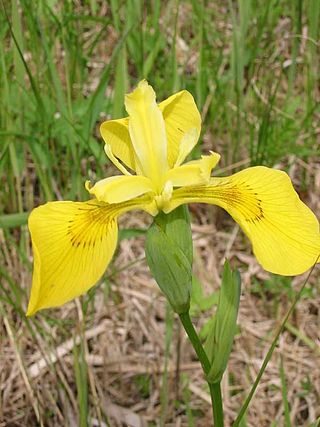
Iridaceae is a family of plants in order Asparagales, taking its name from the irises, meaning rainbow, referring to its many colours. There are 66 accepted genera with a total of c. 2244 species worldwide. It includes a number of other well known cultivated plants, such as freesias, gladioli and crocuses.

The olive-backed sunbird, also known as the yellow-bellied sunbird, is a species of sunbird found from Southern Asia to Australia.

The purple-rumped sunbird is a sunbird endemic to the Indian Subcontinent. Like other sunbirds, they are small in size, feeding mainly on nectar but sometimes take insects, particularly when feeding young. They can hover for short durations but usually perch to lap nectar from flowers. They build a hanging pouch nest made up of cobwebs, lichens and plant material. Males are contrastingly coloured but females are olive above and yellow to buff below. Males are easily distinguished from the purple sunbird by the light coloured underside while females can be told apart from females by their whitish throats.

Leucospermum is a genus of evergreen upright, sometimes creeping shrubs that is assigned to the Proteaceae, with currently forty-eight known species. Almost all species are easily recognised as Leucospermum because of the long protruding styles with a thickened pollen-presenter, which jointly give the flower head the appearance of a pincushion, its common name. Pincushions can be found in South Africa, Eswatini, Zimbabwe and Mozambique.

The Cape sugarbird is one of the eight bird species endemic to the Fynbos biome of the Western Cape and Eastern Cape provinces of South Africa.

The Cape weaver is a species of bird in the weaver family, Ploceidae, found in southern Africa.

The red-winged starling is a bird of the starling family Sturnidae native to eastern Africa from Ethiopia to the Cape in South Africa. An omnivorous, generalist species, it prefers cliffs and mountainous areas for nesting, and has moved into cities and towns due to similarity to its original habitat.
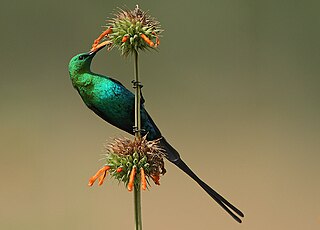
The malachite sunbird is a small nectarivorous bird found from the highlands of Ethiopia southwards to South Africa. They pollinate many flowering plants, particularly those with long corolla tubes, in the Fynbos.

The scarlet-chested sunbird is a species of bird in the family Nectariniidae.
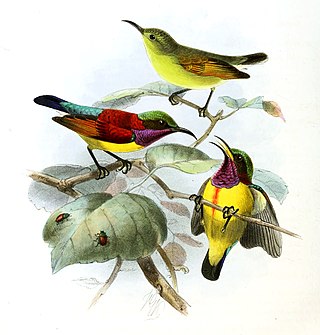
The purple-throated sunbird, is a species of bird in the family Nectariniidae. Its natural habitats are lowland tropical forests and subtropical or tropical mangrove forest of Maratua and the Philippines.
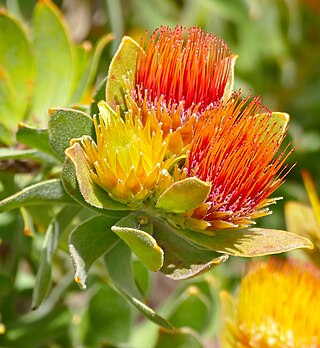
Leucospermum oleifolium is an erect shrub of about 1 m (3.3 ft) high and 1½ m (5 ft) across that is assigned to the family Proteaceae. It has spreading branches, densely set with initially felty, entire, oval, olive-colored leaves of about 3½ cm long and 1½ cm (0.6 in) wide, with a bony tip that sometimes has two to five blunt teeth, with a blunt base and conspicuous veins. The flowers and their long thread-like styles are initially sulfur yellow, but soon become orange and finally turn brilliant crimson. The flower heads are about 4 cm (1.6 in) in diameter, crowded at the tip of the branches with a maximum of five that start flowering in turn. This provides for a colour spectacle from August till December. It is called by various names in South Africa such as Overberg pincushion, flame pincushion, mix pincushion and tuft pincushion. It naturally occurs in fynbos in the Western Cape province of South Africa.
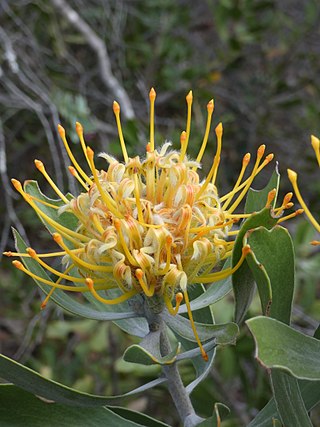
Leucospermum cuneiforme is an upright evergreen shrub with many pustules growing on the lower branches, wedge-shaped leaves, and oval, initially yellow flower heads that later turn orange, with long styles sticking far beyond the perianths, jointly giving the impression of a pincushion. It is called wart-stemmed pincushion in English and luisiesbos (lice-bush) in Afrikaans. The species is common in the southern mountains of South Africa.

Leucospermum calligerum is a softly hairy shrub, with wand-like branches, entire ovate leaves that have a bony tip of about 25 × 6 mm, and globular heads of 2–3½ cm (0.8–1.4 in) in diameter, with two to six together near the tip of the branches and flowering in turn, that consist of 4-merous flowers, initially cream-colored, later pink, with the petals curled and the styles 2–2½ cm (0.8–1.0 in) long, sticking out like pins from a cushion. It is called arid pincushion or common louse pincushion in English and rooiluisie in Afrikaans. Well-scented flowers can be found from July to January. It naturally occurs in fynbos in the Northern Cape and Western Cape provinces of South Africa.

Leucospermum tottum is an upright, evergreen shrub of up to 1½ m high and 2 m (6 ft) in diameter from the Proteaceae. The oblong, mostly entire leaves with a bony tip are somewhat spreading and distant from each other, and so exposing the stem. It is called elegant pincushion or ribbon pincushion in English, and oranje-rooi speldekussing or vuurhoutjies in Afrikaans. Flowers can be found between September and January. The species naturally occurs in the Western Cape province of South Africa. Two different varieties are distinguished, which are genetically very close, but differ in the color, orientation and tube-length of the flowers, the volume and sugar content of the nectar. This is probably an adaptation to different pollinators.

Leucospermum arenarium is a lax, evergreen shrub, with arching and drooping branches, that has been assigned to the family Proteaceae. It has loosely spaced, upright, greyish, narrowly egg-shaped to line-shaped leaves, mostly without teeth and flattened globe-shaped flower heads of 5–7 cm across, consisting of mostly creamy, seldom yellow flowers, that curve in the bud to the center of the head. From the center of the flowers emerge curved styles that jointly give the impression of a pincushion. The common name in English is Redelinghuys pincushion. It only occurs in a very small area in the Western Cape province of South Africa. It flowers between July and October. Unlike in related species the flowers are pollinated by hairy-footed gerbils and striped field mice.






















